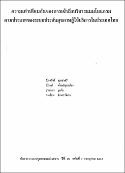บทคัดย่อ
Objective : To describe the characteristics of mammography users and equal access to mammography services by beneficiaries of different insurance schemes.
Setting : Mammography units of nine public hospitals, mamely the National Cancer Institute (NCI), Rachvithi Hospital, Ramathibodi Hospital, Maharaj Chiengmai Hospital, Lampang Hospital, Srinagarind Hospital, Khonkaen Hospital, Songkhlanagarind Hospital and Hatyai Hospital.
Subjects : 1,067 users who completed self administered questionnaire.
Methods : Users were randomly selected from study sites. The number of subjects at The National Cancer Institute NCI, Rajavithi Hospital, Ramathibodi Hospial, Maharaj Chiengmail Hospital, Lampang Hospital, Srinagarind Hospital, Khonkaen hospital, Songkhlanagarind Hospital, and Hatyai Hospital were 122, 125, 124, 119, 127, 124, 60, 136 and 130, respectively. They were requested to respond to a self-administered questionnaire which was developed by the researcher and tested at Songkhlanalarind Hospital. Parameters used in the questionnaire included users’ characteristics, insurance coverage, care seeking behaviour and the modes of their payment of mammography service. Data were collected from July 2002 to April 2003.
Result : The data showed that the beneficiary showed that the beneficiary covered by the Civil Servant Medical Benefit Scheme (CSMBS) was the most common, joined by 60 percent of the recruited users of mammography. The average total expense paid by users, including transportation and mammography, was 1,144 baht. Mammography fee accounted for 81 percent of the expense. Users covered by different insurance schemes paid mammography services differently. The uninsured group took the highest burden at 1,003 baht of mammography service fee, CSMBS paid 1,001 baht, the Social Security Scheme (SSS) paid 798 baht and the universal healthcare coverage (UC) paid, the least, 365 baht
Conclusion : The result showed that users’ expense, both mammography fee and transportation, was an obstacle to people who needed the service. There was unequal access to mammography among different insurance schemes.


